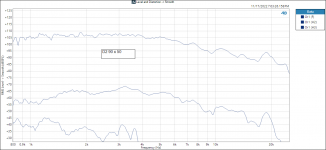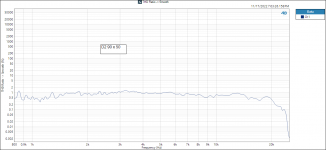Hello,4th order electrical high pass at 500hz is good?
500hz is likely more than a little low.
500hz is likely to over power the HF108r. The test power was less than 1 Watt.
Thanks DT
Take a look at the Faital Pro data sheet recommendations.
Thank you for the plots! HF108R looks good.
Do you have any higher spl measurements? Maybe around 110db at 1 meter.
Do you have any higher spl measurements? Maybe around 110db at 1 meter.
FaitalPro HF-10AK on STH100 Tractrix horn, measurement right at the horn mouth in room. No EQ.

Same as above from 3 ft (90cm)

Same as above from 3 ft (90cm)
Last edited:
Thank you for the plots! HF108R looks good.
Do you have any higher spl measurements? Maybe around 110db at 1 meter.
The speaker was still on the bench.
Microphone was moved to about 1 yard to 1 meter away from the mouth of the STH100.
The microphone and analyzer set to auto calibrate to 2.5khz at 110dbB. See the attached plots.
Note increased distortion. Still not too bad.
Thanks DT


Thank you for the plots! HF108R looks good.
Do you have any higher spl measurements? Maybe around 110db at 1 meter.
https://audioxpress.com/article/test-bench-faital-pro-hf108r-compression-driver
With the year coming to a end is there a way to do a top 3 or 5 , hi-end , mid level, entry level?
I understand there's alot of various things, there is so much info in this post is very hard to compare,
If I am saying this correctly
I understand there's alot of various things, there is so much info in this post is very hard to compare,
If I am saying this correctly
I helped dial-in a 950BePB on a K-402 horn using a DSP crossover, a Xilica XP series, a few years ago, remotely without the benefit of listening. IIRC it required about the same correction as my TAD TD-4002s which I've been running on my own K-402 horns since 2009.
The TADs beat the Celestion Axi2050 by a small margin, in terms of "sparkle" on the highest octave. While the Axi2050 will go one octave lower on a K-402 horn (~230 Hz, which can be useful), both the 950BePB and the TD-4002 cross comfortably on a K-402 at 475-550 Hz using first order filters for home hi-fi duty.
I would recommend the Radian 950BePB based on the above experience over other 2" compression drivers.
Chris
The TADs beat the Celestion Axi2050 by a small margin, in terms of "sparkle" on the highest octave. While the Axi2050 will go one octave lower on a K-402 horn (~230 Hz, which can be useful), both the 950BePB and the TD-4002 cross comfortably on a K-402 at 475-550 Hz using first order filters for home hi-fi duty.
I would recommend the Radian 950BePB based on the above experience over other 2" compression drivers.
Chris
Thank you for the plots! HF108R looks good.
Do you have any higher spl measurements? Maybe around 110db at 1 meter.
Google nice italian site from dibirama...he has tested the 108r thd and amplitude as well.
It is not clear to me the R version is profitable from the non R version with its lower impedance ?!
Yes, if I were going to seek a system-level solution (i.e., loudspeakers, room acoustics, and electronics), I'd recommend bi-amped BMS 4592ND drivers on K-402 horns (or the equivalent sized dual flare straight-sided horns with rounded-over flare). This configuration requires an additional channel of amplification for each loudspeaker, which requires at least an additional stereo amplifier and associated cables, as well as extra output channels on the DSP crossover(s) to accommodate the added "way" in the BMS 4592ND drivers. This assumes a stereo system configuration. Note that I run a dialed-in 5.2 array for listening to high quality acoustic music (and most audible on multichannel SACDs that have been originally recorded since ~2001).I remember you had tested the BMS 4592 tri axial that worked equally fine too...
The reason why I'd go that way is 1) potentially lower overall cost, and 2) reducing FM distortion that might be audible when playing the system at high levels (i.e., the bandwidth of the higher frequency driver is broken into two parts to effectively eliminate FM [Doppler] distortion that is only audible at very high output SPL).
Chris
Thanks. So you like 950be better than TAD 4002?I helped dial-in a 950BePB on a K-402 horn using a DSP crossover, a Xilica XP series, a few years ago, remotely without the benefit of listening. IIRC it required about the same correction as my TAD TD-4002s which I've been running on my own K-402 horns since 2009.
The TADs beat the Celestion Axi2050 by a small margin, in terms of "sparkle" on the highest octave. While the Axi2050 will go one octave lower on a K-402 horn (~230 Hz, which can be useful), both the 950BePB and the TD-4002 cross comfortably on a K-402 at 475-550 Hz using first order filters for home hi-fi duty.
I would recommend the Radian 950BePB based on the above experience over other 2" compression drivers.
Chris
Where can I get K-402 replica?
Btw someone mention that 2" exit driver has flaw by design. The throat is too big so it has resonance low in frequency and low constant directivity behavior?
Is this true? I would love to know everyone opinion.
I said that the 950BePB curved like a TD-4002. I haven't heard the 950BePB. If anyone here has heard it, I'd rely on their experience (hearing is believing).Thanks. So you like 950be better than TAD 4002?
The 950BePB having a beryllium dome diaphragm helps a lot, but witness the JBL drivers that have been retrofitted with Truextent diaphragms. The expected benefits of Beryllium (about 7x better in this application) just aren't there in that ratio--in my estimation.
You can't "get" a K-402 replica, but you can order a KPT-402-HF assembly from Klipsch. They cost about $1200 USD and have a modified BMS DE75 driver attached, and an adjustable base. That's as cheap as it gets to have a new K-402 horn, I'm afraid (their rules, not mine).
If low cost it that important to your project, I'd recommend using Bill Waslo's Synergy Calc spreadsheet. I've got a version of his spreadsheet with a K-402-like dual flare design already embedded in it. All you have to do is to cut the plywood and assemble, paying particular attention to the throat entrance geometry (i.e., making a square-to-round entrance plate). PM for details.
Chris
The issue with any driver exit diameter is related to dispersing the output above a frequency which corresponds to a half wavelength of sound across the throat exit--the sound above these frequencies "beam". For a 2" driver, that's ~6800 Hz at room temperature. For a 1" driver, it's ~13500 Hz, so both have issues, just at different frequencies.Btw someone mention that 2" exit driver has flaw by design. The throat is too big so it has resonance low in frequency and low constant directivity behavior?
There is a fix for this: an in-throat acoustic lens that divides the throat diameter into smaller annular distances:
In my subjective experience, this little 3D printed acoustic lens that slips in between the driver and the horn throat seems to solve that issue. I can now walk off axis at extreme angles to the K-402 centerline and the timbre of the sound doesn't change (i.e., above 6.8 kHz up to the limit of my hearing acuity--which probably is below 20 kHz at reasonable SPL).
This also creates a more realistic decay in-room while listening essentially on-axis. The extreme highs that are reflected off the walls, ceiling and floor sound like they should as if the real instruments or voices are playing in-person (subject to the limitations that the recording engineers placed on their recording via microphone choice and their placement, as well as in-line compression that's typically used).
Chris
Do you know where to get the 3D file for the lens?The issue with any driver exit diameter is related to dispersing the output above a frequency which corresponds to a half wavelength of sound across the throat exit--the sound above these frequencies "beam". For a 2" driver, that's ~6800 Hz at room temperature. For a 1" driver, it's ~13500 Hz, so both have issues, just at different frequencies.
There is a fix for this: an in-throat acoustic lens that divides the throat diameter into smaller annular distances:
View attachment 1113042
In my subjective experience, this little 3D printed acoustic lens that slips in between the driver and the horn throat seems to solve that issue. I can now walk off axis at extreme angles to the K-402 centerline and the timbre of the sound doesn't change (i.e., above 6.8 kHz up to the limit of my hearing acuity--which probably is below 20 kHz at reasonable SPL).
This also creates a more realistic decay in-room while listening essentially on-axis. The extreme highs that are reflected off the walls, ceiling and floor sound like they should as if the real instruments or voices are playing in-person (subject to the limitations that the recording engineers placed on their recording via microphone choice and their placement, as well as in-line compression that's typically used).
Chris
Thanks
Hi milezone, others, have you tried BMS 4544? Its less than half the price of 4552ND or 4550 but seems to be closely related, main specs are about the same and graphs look almost identical. Some aftermaket replacement diaphragms list all these drivers like this one https://www.artsound.gr/product/aftermarket-bms-4550-diaphragm-for-yorkville-7402/While a quote rumor... the driver to test against would be the CP755ND in my opinion. I have a single extra one on hand which I plan to list here or ebay once I get around it. I think it would be worth your while to start there. I would look to drivers that are extended to 20khz only without eq and rule out the rest. Distortion occurs at various points in the higher frequencies depending on the diaphragm material which determines the frequency of breakup modes. This effects the performance of the driver on the whole and those which are more extended and least distorted at high frequencies will preform best.
Much less expensive than the CP755ND, the 1 inch Beyma CP380M is supposedly quite good. I am curious to hear your impressions if you ever do get around to comparing your HF10AKs with any other drivers.
Going after rumours, hard to resist cheap 😀 There might be possibility to order pair of drivers and BMS annular diaphragm drivers are tempting as they are clearly different kind of driver than the HF10AK I have, price of 4544 is not too high either. Main difference seems to be distortion performance < 1kHz which doesn't look too big to me as its for home hifi.
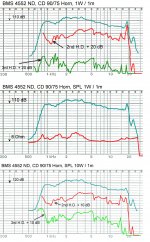
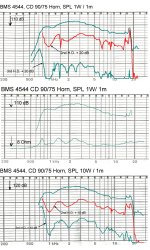
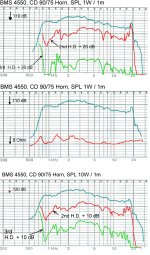
- Home
- Loudspeakers
- Multi-Way
- Best Compression Drivers today 2022?
